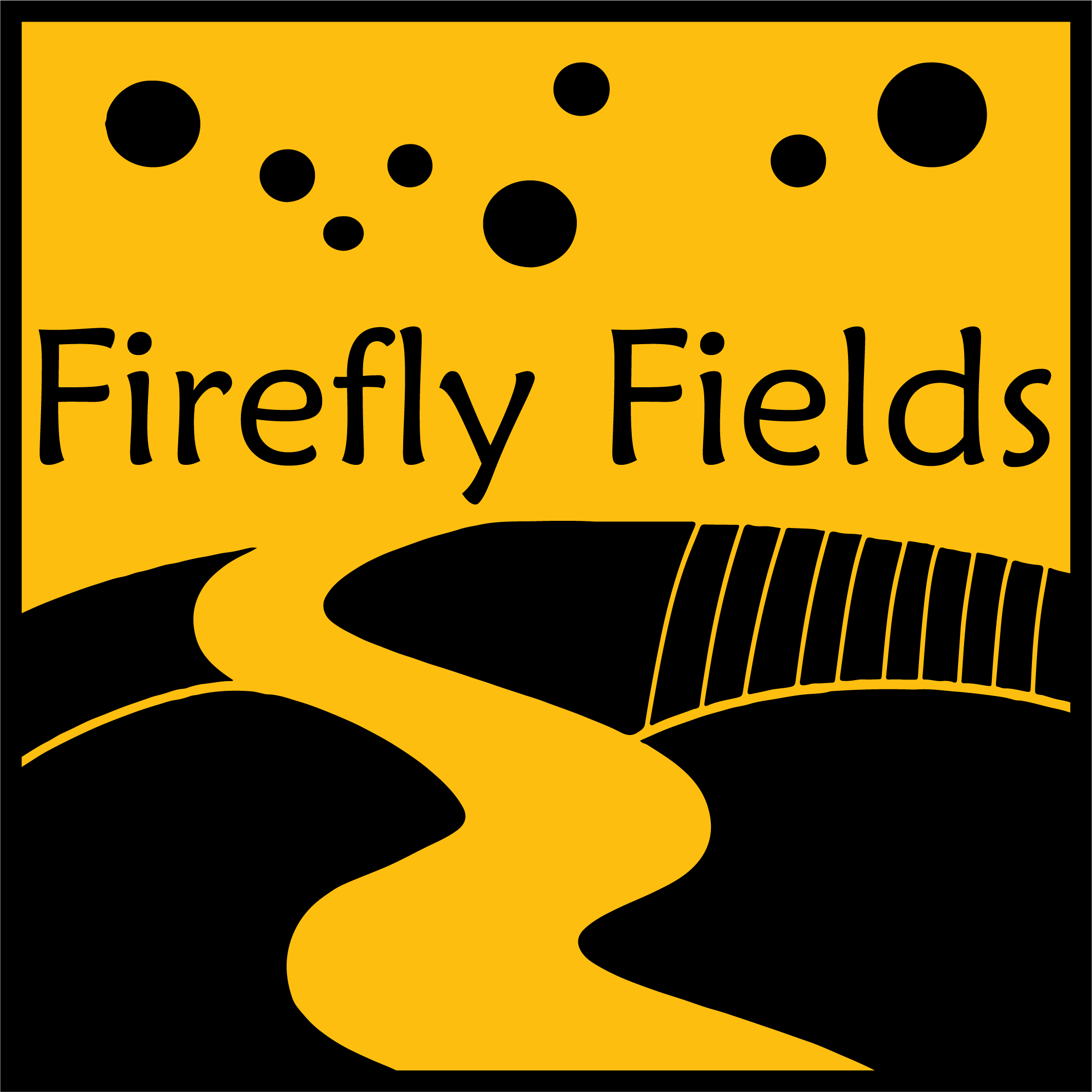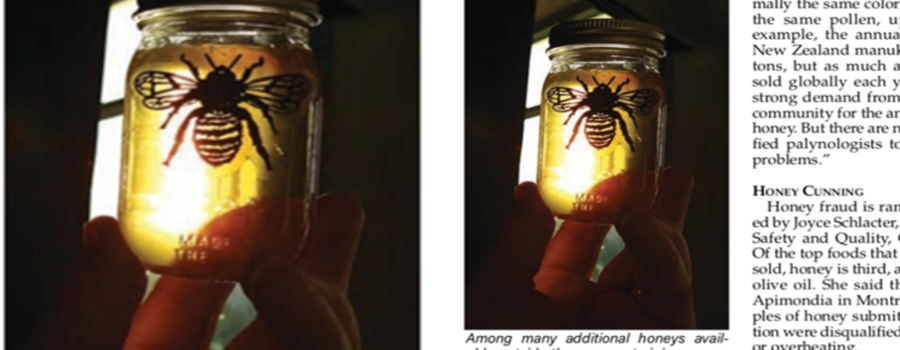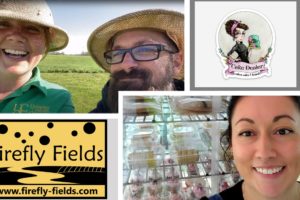Without doubt, the months of May and June contain the most hectic days on the farm. From field preparations (e.g. picking rocks, tilling soil, prepping equipment, planting seeds, replanting seeds, hoeing weeds, praying for rain, etc.) to launching farmer’s markets and all kinds of other essential tasks. So, as we rise up for air from the manic mode of this season, and check to see if the corn is ‘knee high by the Fourth of July’ – it is AWESOME to find our Firefly Fields’ honey bee label featured in May’s edition of the American Bee Journal.
It’s funny, but we really haven’t had time to fully comprehend this exciting (and kinda monumental) event until recently. During these Covid-times, you hear people talk about this phenomena of a ‘pause.’ A pause, in which, if you’re one of the lucky ones, you’re able to slow down the pace of life’s business, and have a chance at really digging-in to self-reflection on your life, your family, your work, etc. In this present moment of global uncertainty, farmlife has continued to march on and in some ways to a busier beat than ever. Continuing its regular pace, life on the farm is consumed with constant changes demanding responsiveness to fluctuating environmental variables that seem to flux from one extreme to the other (e.g. 6 inches of rain in 24 hours, no rain for six weeks). Typically, each year come July 1, the day of reckoning arrives and we take a moment to lift our heads from the ground work to peak and see if the odds are pointing in our favor and there will be fruits for all our labors.

Sharing Honey with Experts
Back in November of 2019, Virginia attended a Honey Sensory Evaluation Training at the University of California, Davis. It was her birthday present to herself, and a step toward becoming a ‘mieleur.’ Mieleur is used to describe a honey sensory expert, like a sommelier is used to describe an expert of wine. During her time at UC Davis, she learned how to tune her human sensory skills to parse out different varietal honey flavors as well as engage with people from all over the world in love with the mesmerizing properties of honey. Did you know humans can smell 10 million odors, and our sniffers are as good as any dog’s? We need only to use and practice with these super human powers to refine our abilities. For three days, she sniffed, huffed, and delighted in honey varietals from all over the world. Zeroing in and focusing this skill in the hopes that she may bring this passion and knowledge to her local community in and around the midwest.
Of course, it was natural for all the attendees of the workshop to bring their own honeys to share with other connoisseurs to taste and test varietals from many landscapes across the globe. It was here, that the Firefly Fields honey label was discovered and later shared with the American Bee Journal. What’s unique about the label? It’s an anatomically correct (mostly correct) rendering of a honey bee, drawn by Virginia and digitized by Ben.

Honey Fraud
Ultimately, authentic, high-quality honey should be thought of like a fine treasure such as wine, chocolate, coffee, or olive oil to be savored and appreciated in a way that brings high consumer demands and a price that matches that demand. However, honey is currently in a bit of a crisis where many beekeepers are unable to even fetch a price for honey that covers production costs. Crazy, right?
The reason: honey fraud. Honey fraud is running rampant. Honey gets cut with cheaper sugars – malt syrup, rice syrup, corn syrup, etc. Bees are even intentionally fed with sugar for harvesting. Most of the fraudulent honey enters the U.S. borders via mislabeled Chinese suppliers that transship from Taiwan, India, Malaysia, and other countries. A honey criminal need only log on to Alibaba (the Asian equivalent to Amazon) to purchase an exquisite manufacturing apparatus to produce fake honey from cheap sugars and flavorings with a dash of artificially collected pollen. YIKES!
Ultimately, this results in the loss of revenue for real honey producers and consumer trust as these fake products flood the market. Another story for another day! Bottomline: purchase honey made by honey bees from reliable, local beekeepers. And, this brings us to some of the very motivation and inspiration behind the Firefly Fields honey label.

Giving Credit Where Credit Is Due
We might sound a little snooty, but we feel like the plastic honey bear as the keeper and holder of liquid gold is a bit of a pretender too. Nothing against the cute convenience of these plastic, squishy bears, but there’s a lot of confusion out there about where food comes from. With all the fraud and deep fakes, let’s give all credit where credit is due. In this story, the credit goes to the honey bee, Apis mellifera.
A couple years ago, when we started thinking about bottling and selling our honey – we did a lot of thinking and research. Virginia was pretty adamant about putting a honey bee on the jar. She came across an older pamphlet online produced by one of the land grant universities through the Agricultural Extension Services providing guidelines and suggestions to honey producers on bottling and selling honey. The research-based guidelines strongly discouraged the use of the honey bee image as a market label because it would be off-putting to a consumer to see an insect on a jar.

An Act of Defiance
Sometimes you just have to go with your gut. We wanted to have the honey bee featured together with the honey it produces. Simple? YES! No bears, no plastic, just honey and the honey bee on glass. Virginia sketched a honey bee trying to get the dimensions of the worker bee just right, and Ben transformed the drawing in Adobe Illustrator into a template that could be used as a screenprint or sticker label. We haven’t looked back since. Instead of the sight of an insect being repulsive, we often find people drawn to our jars at the market. Customers appreciate the realism, stopping by our vendor’s booth just to comment on the ‘pretty jars and bees.’
This is a moment to celebrate! The American Bee Journal has been the ‘Beekeeper’s Companion since 1861!’ For nearly 160 years, the journal has been the source for all things honey bee related (e.g. economics, biology, ecology, art, honey, etc.) Its origins date back to Langstroth, the maker, creator of today’s modern beehive. It’s SUCH an honor to see our honey bee label mounted upon the glow of raw honey in the sunlight (photo credit: Kathy Keatley Garvey – insect photography guru). Could there be anything more beautiful? There’s no coincidence that when we designed the label, we wanted to feature the amazing creature responsible for this ‘nectar of the gods,’ the honey bee. Let us always remember the true honey hero, and never be afraid to keep it real!

Thanks for reading our celebration story. What do you think about labels? Do they matter that much? Please leave us a comment below. We want to hear from you.






Leave a Reply
Your email is safe with us.